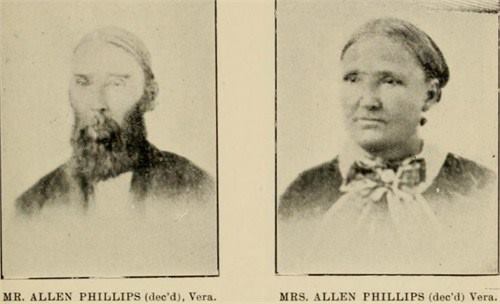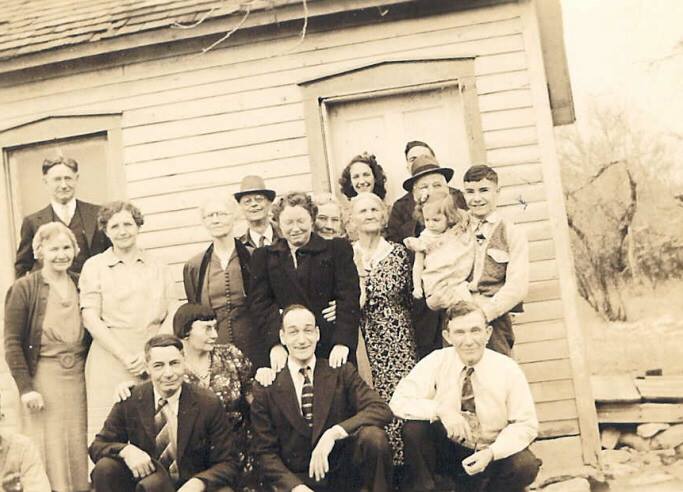I have a rare commodity today: time. So I want to continue writing about Wilbur V. “Jack” and Mabel Edith (Phillips) Herron and their families.
In my last article about them, I think I finished bringing my gentle readers up to the arrival of the Herron Family in Wabaunsee County, in about 1890. So lets now talk a little about the Phillips Family.
Mabel (Phillips) Herron was the granddaugther of Allen Albert and Mary (Graham) Phillips. In Matt Tompson’s 1900 “Wabaunsee County History” there is an interesting article about the elder Phillips, but it must have been submitted by another family member since both Allen and Martha were long dead.
Allen Phillips or “Al” as both he and his son were called, was born on June 12, 1819 in Terre Haute, Indiana. I have to admit complete defeat on trying to go further back into the families ancestry. I have looked and looked but can’t find a family in Terre Haute at that time that might be his parents.
I do know from family oral tradition that Al Phillips had the benefit of a good education in Terre Haute Schools, and that his parents apparently gave him some kind of financial assistance to begin his farming career.
Al Phillips was married to Mary Elizabeth Graham, on March 3, 1836 in Terre Haute, Henderson County, Illinois, just across the Wabash River from Terre Haute, Indiana. Again, I’ve been stymied in trying to find Mary Graham’s family, but remember, only the head of household was named on US Census reports until 1850. The wives, children and other household members were simply enumerated without exact ages or names.
Al and Mary Phillips lived in Henderson County, Illinois for a few years and then moved to Wisconsin, where they purchased a second farm. They didn’t remain in Wisconsin long, removing to Liberty, Johnson County, Iowa where Al was successful in farming and was able to accumulate about 800 acres of land worth in 1850, some $12,500.
Al also entered into some very risky ventures. For instance, he bought 100 horses in Iowa, and got his family and others to help him drive them to California 1852. He was actually counted on the 1852 California Census in Sacramento. His occupation is listed as “drover.”
He returned to Iowa and continued farming until 1862, when he made a second trip to California. I have not been able to learn the purpose of the trip, but it must have been to haul goods for sale or prospect for gold. That information is lost so far as I know.
When Al Phillips learned that the Potawatomi Indian Reservation was going to be sold and opened to settlement, he sold his land in Iowa and made two trips to Kansas to look at land. He chose 1,000 acres on the south edge of the Reservation, south of the Kansas River, in what is today Newbury Township. Today, this land is part of the Gideon Farm and was until recently sold a part of the Clothier Property on the east side of Vera Road.
He had 480 acres of the land broken for wheat and the remainder was used for hay and pasture. He built a log house, which lasted well into the 1940s, and moved his family to the farm/ranch from Iowa. They arrived in the fall of 1868.
Al Phillips plunged into the civic and agricultural life of the new settlers that were arriving to purchase farms on the former Potawatomi Reservation. Al because a member of the Newbury Township Board and was one of the five men who were the original incorporators and planners of the Town of Newbury. He ran successfully for a seat on the Wabaunsee County Commission in 1872 and was serving in that capacity when his life came to a sudden end in 1873.
Al and Mary Graham’s entire family accompanied them on their move to the Vera Community. Some were already married and bought farms adjacent to the Phillips Farm/Ranch. His oldest son, Levi M. Phillips moved to North Topeka, Kansas and became post master. On a pretty spring day in June, 1873, Al and Mary Phillips left their ranch in their surrey and drove to North Topeka, where they spent several days with their son Levi and his family.
They began the trip back to Wabaunsee County on the morning of Saturday, June 30, 1873. They had traveled about one hour west of Topeka, and were just going to ford Mission Creek at Moon’s Crossing, when they were overtaken by a terrible storm. The storm came up so quickly they didn’t have time to seek shelter. Moons Crossing was just about where I-70 crosses Mission Creek west of the K-4/Auburn Road exit.
What happened exactly is not known. But a lightening bolt evidently struck the Phillips as they crossed Mission Creek killing them both instantly. The next morning, their son Al Phillip, Jr. went to the barn to feed livestock, and found his parents dead in their surrey. The horses and the surrey were unharmed.
The family chose a one acre plot of ground on a hill on the ranch to begin a Phillips Family Cemetery. The cemetery is just to the northwest of the Merle and Nora Lietz Farm. The Phillips were the first burials there. Since, there have been more than a dozen.
When Al and Mary Graham Phillips came to the ranch, they found several huge boulders that had been hollowed out by Native Americans. It’s likely that they were used to grind grain. The family took two of these boulders and placed them on their parent’s graves.
One remains today, and the other was taken to the home of Jack and Mabel Herron in Maple Hill where they placed it by their driveway and made a flower planter out of it. As they grew old, they realized the historic value and took the stone to the Wabaunsee County Historical Society where it is on exhibit today.
In the next article I will talk about the children of Alfred E. and Hannah (Gardner) Herron and Allen Albert and Mary Elizabeth (Graham) Phillips.
The first photograph is of Allen and Mary Elizabeth (Graham) Phillips.
The second photograph was taken in about 1910 at their home in Vera. The log house had been sided with sawn horizontal boards by then and was the home of Allen Phillips, Jr. and his wife Ada (Jones) Phillips.
Nick Clark, Page Administrator

